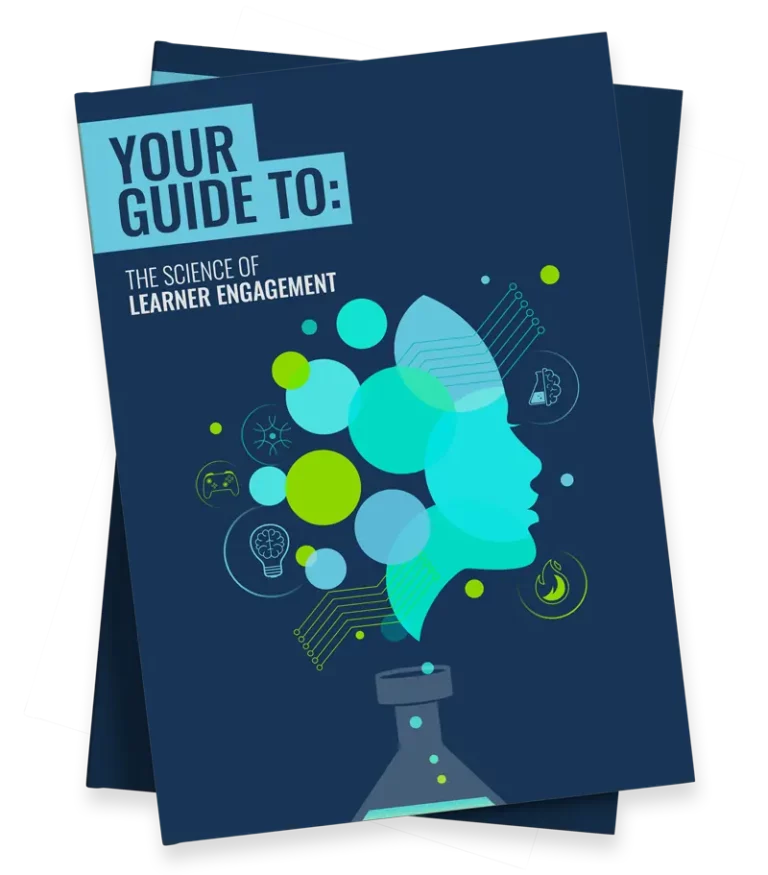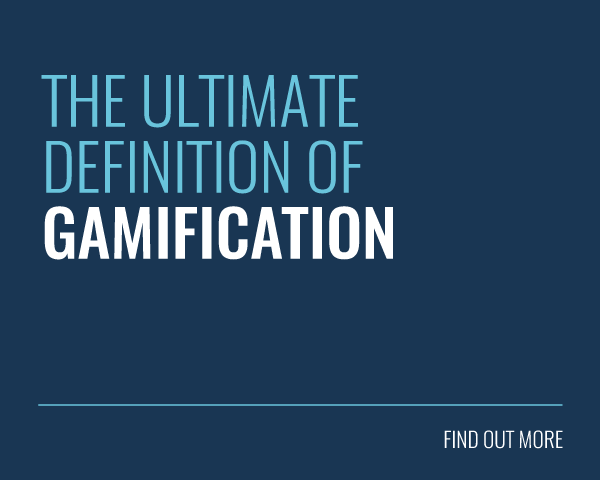
In today’s dwindling attention economy, engagement is the ultimate currency. Yet only 21% of employees globally feel truly engaged at work. For learning professionals, this challenge intensifies: how are we supposed to motivate learners who are already stretched comically thin?
As the revered American football coach and leadership guru, Homer Rice, once observed: “You can motivate by fear and you can motivate by reward. But both these methods are only temporary. The only lasting thing is self motivation.”
It’s the classic ‘horse to water’ dilemma. We can provide world-class learning platforms, but can we actually make people thirsty for knowledge? Well, the answer lies in understanding motivation’s twin engines:
- Intrinsic motivation (the internal drive to learn and grow)
- Extrinsic motivation (external rewards and recognition)
In this article, we’ll dissect decades of research to uncover the true power of both approaches. We’ll also pinpoint exactly when and how to use each reward type within your learning programmes. Feeling motivated? Then let’s jump in!
Motivation: Understanding What Drives Us
At its core, motivation answers the question: Why do we do what we do?
Motivation is the invisible force that ‘moves’ us to act. Whether that’s tackling a challenging work project, hitting the gym, or even (yes) heroically mustering the will to complete your mandatory compliance training.
Put another way, it’s the psychological drive that initiates, guides, and maintains our goal-oriented behaviour. Without motivation, even the simplest tasks can feel exhausting. But with it, even the hardest challenges become exhilarating.
In learning, motivation isn’t just helpful, it’s essential. You can have the most dazzling learning platform and cutting-edge content, but if your learners don’t log in (or only engage passively), then you’ll never make a real impact.
Of course, motivation isn’t one-size-fits-all. Some people are fueled by passion, while others respond to rewards or deadlines. Let’s explore this distinction further.
Intrinsic Motivation: The Inner Spark

Intrinsic motivation is the drive to engage in an activity purely for the satisfaction and enjoyment it brings, without the need for external rewards. It’s typically fuelled by internal desires such as curiousity, personal interest, and the joy of mastery.
Here’s how the masterminds behind Self-Determination Theory (more on this shortly), Richard Ryan and Edward Deci put it: “Intrinsic motivation is defined as the doing of an activity for its inherent satisfaction rather than for some separable consequence”.
In other words, it’s the difference between:
- Learning to play the guitar for the love of music (intrinsic)
- Learning to play the guitar to impress your crush (extrinsic)
Think about your favourite hobby. The one you’d do for hours without checking the clock. No one’s forcing you to do it. No paycheck awaits you. You do it simply because it lights you up. This is intrinsic motivation in its purest form, and psychology tells us it springs from three powerful needs.
Self-Determination Theory
According to Self-Determination Theory, there are three core psychological needs that fuel intrinsic motivation. When you combine these ingredients, we start to engage in activities with more energy, creativity, and joy. Here’s the breakdown:
- Autonomy: We’re not cogs in a machine. Instead, we’re wired to crave control. This is our need to feel like the author of our actions, not just a passenger. If we’re stripped of choice then our motivation quickly flatlines. Conversely, choice grants us a meaningful sense of ownership.
- Competence: Ever quit a game that was too hard, or too boring? That’s competence at work. This is our need to feel effective and capable in the way we interact with the world around us. It feels good to cultivate a sense of growing mastery and frustrating when we’re just treading water.
- Relatedness: This is our need to feel connected to others and to belong to a wider community. It’s the difference between ‘I have to do these admin tasks’ and ‘My team’s counting on me’. When our actions connect to people or purpose, motivation quickly follows.
Extrinsic Motivation: The External Push

Now, let’s shift gears. While intrinsic motivation comes from within, extrinsic motivation is all about the external rewards and pressures that drive us to act. Instead of finding joy in the activity itself, we do it to avoid a distinct outcome or consequence.
To help us understand this concept better, let’s hear from our friends Ryan and Deci again: “Extrinsic motivation is a construct that pertains whenever an activity is done in order to attain some separable outcome”.
Put another way, it’s the difference between:
- Working overtime to get a bonus (extrinsic)
- Working late because you love your project (intrinsic)
While cash bonuses and other financial rewards might be the first extrinsic motivators that come to mind, the truth is far more exciting. Effective learning programmes typically use a creative mix of rewards that tap into our deeper psychological drivers. For example:
- Gift cards (such as Amazon vouchers)
- Course vouchers (free access to premium courses)
- Merchandise (branded notebooks, pens, mugs, etc.)
- Prize draws (raffles for bigger rewards)
- Paid time-off (half-day off for top performers)
- Mentorship opportunities (1:1 time with senior leaders)
- Digital rewards (badges, XP, certifications, etc.)
- Public recognition (‘Employee of the Month’ spotlights)
- Exclusive access (or first access to invite-only content)
- Career progression (tied to specific learning milestones)
Now, you might be thinking that extrinsic motivation sounds like the ‘bad cop’ to intrinsic motivation’s ‘good cop’, but it’s not that simple. It’s not inherently worse, it’s just different. With that said, there is one critical pitfall that you need to look out for.
The Overjustification Effect:
What if paying someone for their passion killed their love for it?
This is what’s known as ‘the overjustification effect’. It’s a sneaky psychological trap where offering an extrinsic reward for a behaviour that was already intrinsically motivating erodes that person’s intrinsic motivation over time.
One of the earliest demonstrations of this effect came from a 1971 study by Edward Deci (yes, him again!). He found that participants who initially enjoyed solving puzzles lost interest after being paid to do it. The internal spark had died out.
Sound familiar? Ask anyone who has turned their hobby into their job and you’ll hear a similar story. “I used to paint for joy. Now it’s just deadlines and meaningless commissions”. But, this begs another question: why exactly does this happen?
Well, if we continue to lean into Self-Determination Theory, the primary culprit is often a perceived loss of autonomy. When an activity suddenly becomes tied to external rewards, our brain re-evaluates why we’re doing it. It may feel less like a personal decision and more like an obligation.
Of course, it’s rare that the conditions created by Deci and co. are replicated in real life. It’s also true that bonuses get results. Still, it’s a fantastic reminder for us in the learning world that we can’t just throw rewards at everything and expect magic.
Intrinsic Motivation vs Extrinsic Motivation: Which is Best?
Is it the pure joy of discovery, or the promise of a shiny badge, that truly fuels impactful learning? If you’ve been following along, you might already have a hunch. The answer, like most things in the complex world of human behavior, isn’t a simple either/or.

Instead, your ultimate goal should be to create a potent mix of both. As this 2024 study puts it, ‘both extrinsic and intrinsic rewards in humans are necessary to acquire competence, and optimally manage real-life settings’.
With that said, understanding the nuances between these two powerful forces is crucial for designing effective learning experiences. Here’s a clear comparison:
| Feature | Intrinsic Motivation | Extrinsic Motivation |
| Source | Internal (comes from within the individual) | External (comes from outside the individual) |
| Focus | The activity itself and enjoying the process | The outcome or reward associated with the activity |
| Reward | Internal satisfaction, joy, curiousity, achievement, personal growth | Tangible rewards (money, grades, bonuses), praise, recognition |
| Sustainability | Long-term and self-sustaining | Short-term and conditional |
| Learning Impact | Leads to genuine curiousity and deeper understanding | Leads to surface level learning (doing just enough to get by) |
Motivational Drives: The Research
We’ve touched on some big ideas about motivation. Now, it’s time to see what the evidence says. What does the research really reveal about the driving forces behind engagement in both our careers and learning journeys?
- McKinsey data suggests that intrinsically motivated employees are 32% more committed and 46% more satisfied in their roles.
- A meta-analysis of 225 studies confirms that happier employees are, on average, 31% more productive.
- And this 2012 study found that intrinsic motivation had 3x greater impact on employee engagement levels than extrinsic motivators.
Moreover, a 2022 meta-analysis of 124 workplace motivation studies revealed that intrinsic motivation is ‘by far’ the strongest predictor of positive outcomes, including engagement, job satisfaction, and commitment. It found that:
- 45% of motivation comes from fulfilling work (intrinsic)
- 22% stems from personal values (intrinsic)
- 12% is driven by pride and shame (extrinsic)
- 9% relies on rewards and punishments (extrinsic)
In other words, 67% of workplace motivation is fuelled by internal drives, while extrinsic factors account for just 21% (with the remaining 12% being difficult to categorise). The message is clear: lasting performance and satisfaction comes from meaningful work, not external incentives.
So far so good, but what does more recent research say about these two drives?
- A 2024 study of 150 South African knowledge workers confirmed a ‘positive relationship between intrinsic motivation and innovative work behaviour’.
- 2025 research found that ‘seductive details’ (interesting but irrelevant information) harm learning in extrinsically-driven environments, but boost outcomes when learners are intrinsically motivated.
- And a 2025 study of Tanzanian public sector workers revealed intrinsic motivation to be 3.3x more effective at improving job performance than extrinsic rewards.
Practical Motivational Guidance
With all this research in mind, we’re getting a sense of what works and what doesn’t. We’ll soon explore how to strike the ideal balance within your learning initiatives, but first, here are three foundational principles to anchor your approach.
- Build for Lasting Motivation: Intrinsic motivation turns learning into a lifelong passion, not just a task. When learners are driven by personal fulfillment, they persist through challenges, engage more deeply, and work towards true mastery. Ultimately, this self-sustaining drive leads to longer retention, higher creativity, and better adaptability.
- Use Rewards Strategically: While extrinsic motivation shouldn’t be the primary driver for learning, it does have a role to play in your learning programme. After all, let’s face it: not every learning task is inherently fascinating. For compliance training, foundational skills, and administrative tasks, a clear reward can provide the necessary nudge to get learners started.
- Find the ‘Just Right’ Balance: The key is to find the perfect balance between external pushes and internal interest. You should design content and experiences that naturally tap into learners’ desire for autonomy, competence, and relatedness (more on this shortly), while employing extrinsic motivators for ‘must-do’ tasks. Your goal should be to make motivation feel organic, not imposed.
Finding the Balance for Your Learning Programme

With all this in mind, the path forward for learning professionals becomes clear. Our primary goal should be to cultivate intrinsic motivation across our audience, while using extrinsic motivators strategically and with precision.
Ready to make that happen? Here are our tips:
Fostering Intrinsic Motivation
- Autonomy: To ignite intrinsic motivation, start by giving your learners real agency over their experience. Let them select topics, modules, and projects that align with their specific interests and career goals. Where mandatory content is unavoidable, show how it solves real problems or unlocks future opportunities. This ‘why’ (or WIIFM) bridges the gap between requirement and relevance.
- Competence: Next, help your learners to track their progress, so they feel effective and capable. Start by scaffolding your content, or breaking it down into logically-ordered chunks. Then ensure your learners know what success looks like and how to achieve it. Your feedback should clearly show learners where they’re making mistakes and offer actionable steps for improvement.
- Relatedness: Finally, create a learning environment where your audience feels supported, connected, and valued. Here, you’ll want to lean into social learning and knowledge sharing. Choose platforms with built-in social features where learners can ask questions, celebrate wins, and gain recognition from both instructors and their peers.
For maximum impact, you’ll want to combine all three of these psychological needs. In doing so, you create fertile ground for learners to develop a growth mindset. This fundamental belief in our capacity to grow and improve is a powerful engine for sustained individual and organisational success.
Fostering Extrinsic Motivation
- Meaningful Rewards: The secret to extrinsic motivation isn’t to shower your learners with rewards. Instead, you should match meaningful incentives to the effort required. For dull-but-necessary training, think like a gamer: offer tiered rewards, surprise perks, and status boosts. Just remember: even the shiniest reward feels hollow without genuine recognition of the work behind it.
- Game Mechanics: Gamification leverages external rewards to make learning more engaging. For instance, you could award digital badges or experience points when learners complete modules, pass quizzes or participate in discussions. Leaderboards are also great for fostering healthy competition and helping your learners to build a sense of status within the community.
- Career Advancement: To truly motivate, show your learners how their efforts directly translate to professional growth. Highlight how specific programmes lead to promotions, new roles, or increased responsibilities. And don’t forget to bring in senior leaders and successful peers to share their stories and demonstrate the real-world impact of continuous learning.
Of course, all of this becomes much easier if you have a centralised platform to manage your content, rewards, and engagement analytics. In fact, a modern learning management system acts like a motivation control centre, so you can spend less time juggling systems and more time inspiring growth.
Final Words
So, there we have it. While extrinsic rewards often get a bad rap, they absolutely still have a strategic role to play in your learning programmes. Think of them as valuable nudges that can push your learners across the finish line when they need extra encouragement.
However, the true fuel of deep, sustained learning is intrinsic motivation. This is motivation that springs from within, driven by a sense of autonomy, competence, and relatedness. It’s ideal for helping learners to achieve their long-term growth goals.
By shifting your focus, you’ll empower learners to take true ownership over their development, cultivating a growth mindset, and unlocking their full potential. As a bonus, you’ll finally stop wasting budget on forgettable rewards that end up in desk drawers.
That sounds like a win to us!
Thanks for reading. If you’ve enjoyed this content, please connect with me here or find more articles here.
Intrinsic motivation and extrinsic motivation are just one fascinating piece of the puzzle that is learner engagement. For the full story, download ‘Your Guide to the Science of Learner Engagement’ now!









